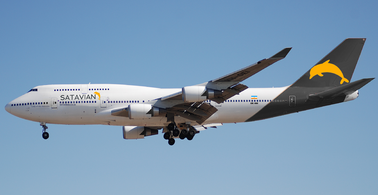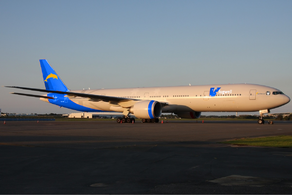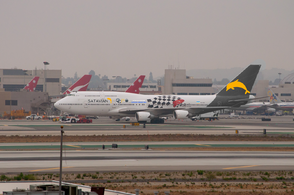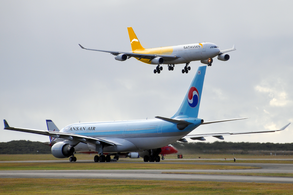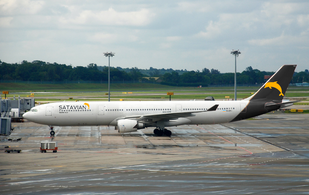Satavian Airlines: Difference between revisions
| Line 210: | Line 210: | ||
|- | |- | ||
|[[Castelonovo]]||{{flag|Belmonte}}||[[Júlio Lobato-Castelonovo International Airport]] | |[[Castelonovo]]||{{flag|Belmonte}}||[[Júlio Lobato-Castelonovo International Airport]] | ||
|- | |||
|[[Sermoni]]||{{flag|Bonaventure}}||[[Erberto Ceccareli International Airport]] | |||
|- | |- | ||
|[[Andade]]||{{flag|Cassier}}||[[Andade International Airport]] | |[[Andade]]||{{flag|Cassier}}||[[Andade International Airport]] | ||
Revision as of 16:01, 15 April 2022
 | |||||||
| |||||||
| Founded | 23 January 1935 (as Satavian Imperial Airways Corporation) | ||||||
|---|---|---|---|---|---|---|---|
| Commenced operations | 18 December 2007 (as Satavian Airlines) | ||||||
| Hubs | Port Hope/O'Connell | ||||||
| Secondary hubs | Port Arthur/Fort Kinnon Victoriaburg | ||||||
| Frequent-flyer program | Dolphin Club | ||||||
| Alliance | Sky Alliance | ||||||
| Subsidiaries | SatavianExpress Vlugwell | ||||||
| Fleet size | 98 | ||||||
| Destinations | 65 | ||||||
| Parent company | Government of Satavia (66%) | ||||||
| Traded as | PHSX: SATX | ||||||
| Headquarters | Greystone, Port Hope, National Capital District, Satavia | ||||||
| Key people | Derek Moyne, Chairman Jack Lawson, CEO | ||||||
| Revenue | |||||||
| Operating income | |||||||
| Net income | |||||||
| Employees | 18,339 | ||||||
| Website | satavian | ||||||
Satavian Airlines Corporation Ltd, commonly known as Satavian Airlines, is the flag carrier of Satavia and its largest airline by fleet size, international destinations and passengers carried. Satavian Airlines is one of the world's oldest airlines through its predecessor companies, with Satavian Imperial Airways Corporation, commonly known as SIAC, the oldest of those, founded in 1935 to provide a trans-Vehmens service from Port Hope, at the time capital of the Dominion of Satavia to Morwall, Estmere. Satavian Airlines dominated the Satavian commercial aviation industry during the late 20th century and into the early 21st century but struggled to survive following the 2005 global financial recession. In 2006, the airline fell into enormous debt, before being rescued by the Norton government, which began a huge reconstruction process that saw the airline lose a large portion of its market share both internationally and domestically.
Satavian Airlines remains one of the largest airlines in the Asterias, and is a founding member of Sky Alliance, the world's second-largest airline alliance, through its predecessor Air Satavia. Satavian Airlines operates a fleet of 98 aircraft, across 65 destinations on all four inhabited continents. The airline operates primarily out of its main hub in Port Hope O'Connell International Airport, the larger of the two airports that service Port Hope, in addition to smaller operations originating from Port Arthur-Fort Kinnon International Airport and Victoriaburg Fort Zilverzee International Airport. Its headquarters are in the Greystone suburb of Port Hope, adjacent to Port Hope/O'Connell Airport, situated in Burnaby.
The airline operates a fleet consisting of Airbus A220, Airbus A320, Airbus A321, Airbus A330, Airbus A350, Boeing 747 and Boeing 787 aircraft. Following the nationalisation of the airline in 2006, the airline moderninsed it's ageing fleet. The airline has won Airtrax Best Asterian Airline for three consecutive years, in 2017, 2018 and 2019.
History
1935-1939: The early years
Following Satavia's liberation towards the end of the Great War, Neville Moyne, a wealthy Estmerish businessman, sought to connect Satavia, at the time a part of the Estmerish Empire, to Morwall. On 23 January 1935, Satavian Imperial Airways Corporation, operating a Armstrong Whitworth Atalanta aircraft, flew the first trans-Vehmens flight of the Airline, carrying eleven passengers (including Moyne) and mail. The aircraft, registered G-SVAA Dominion, flew Port Hope-Fort Kinnon-Kingsport-Port Fitzhubert-Montecara-Bouley before arriving in Morwall on 14 February, to find that the war had ended.
Within the same year, the airline (now partly-owned by the Imperial Airways Corporation) had expanded its operations to become the largest airline in Satavia. When Satavia declared independence in 1936, the airline's focus was diverted from operating the Port Hope-Morwall connection (although it maintained this route, with less frequent flights) to the Asterian market. In 1937, SIAC began operating flights to Asteria Inferior for the first time, with a twice-weekly rotation from Port Hope Aerodrome to Liberty City Airfield. Later that year, Neville Moyne took the opportunity to raise capital for four brand new Spartan Cruiser aircraft, decreasing his own stake in the company to 33%. By 1939, the airline had grown to become one of the largest in Asteria Inferior, and had acquired many of its rivals in the region. In February 1939, a military coup displaced the elected government and brought an end to the Union of Satavia.
1939-1988: Satavian Airways and merger with SRA
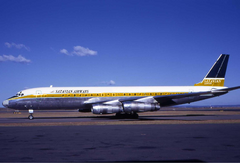
By late 1939, tensions between Satavia and some of its Asterian neighbours hostile to the coup forced the airline to cancel many of its international routes - including the Port Hope-Morwall connection that the airline had been founded upon. The effects of this, coupled with a financial crisis that gripped the nation in the aftermath of the coup forced the airline into debt. In response, the Satavian military government nationalised the airline, rebranding it as Satavian Airways. For much of the 1940s, the airline struggled to turn a profit whilst running primarily domestic routes and started losing out to privately-owned competitors, such as Satavian Regional Airlines. SRA became Satavian Airways's largest competitor and began a price war which saw aviation in Satavia increasingly become more accessible and cheaper to the wider public before it did in many other nations.
The price war continued into the early 1950s but was ultimately unsustainable for both airlines, and so resulted in the Aviation (Pricing & Regulations) Act, 1955 which saw both airlines forced to abandon many competing routes in an attempt by the government to control the airlines. Whilst Satavian Airlines had lost significant ground domestically, it had an effective monopoly on international routes originating in Satavia, and was able to rapidly expand into friendly Asterian states.
In the 1960s, Satavian Airways would be revitalised and began to target the leisure market that had previously been the domain of other Asterian carriers, such as Nuvanian flag-carrier NLM and the Imaguan Civilian Air Service, which both offered more competitive prices. Satavian Airways offered Asteria's first package holiday in 1961, with a flight from Port Hope/O'Connell to Peter Hansson International Airport in Imagua.
By the late 1960s, Satavian Airways' main competitor, SRA, had fallen into debt as it struggled to keep up with Satavian Airways and its significantly larger budget. In 1969, SRA went into a state of insolvency, and facing the collapse of Satavia's second-largest airline prompted the government to pass the Aviation (Insolvency, Protection & Mergers) Act, 1969 which allowed for the merger of Satavian Airways and SRA. Satavian Airways now dominated the Satavian aviation industry, and the coup that lead to the installation of a democratically elected government in 1976 allowed Satavian Airways greater access to the international market. For the first time since 1941, the airline re-opened the Port Hope-Morwall connection, operating with just one stop in the city-state of Montecara before operating non-stop from 1979 with a Boeing 747-200.
For the early part of the 1980s, Satavian Airways prospered as it was the only major airline in Satavia, capturing both the business and leisure market. Its rapid expansion across Euclea was remarkable, and soon it operated one of the world's largest fleets.
1988-2007: Air Satavia and downfall

In late 1988, with the election of a Conservative & Country government, a huge privatisation programme began in Satavia, that saw a vast majority of state-owned enterprises sold to investors - and in December 1988, Satavian Airways was listed on the Port Hope Stock Exchange for the first time. A consortium led by Arthur Moyne (son of Neville Moyne, founder of Satavian Airways' predecessor) and the Estmerish-Jindanese conglomerate the Dane Group acquired a controlling stake in the company. The airline was re-branded as 'Air Satavia' and continued its rapid expansion plans.
In 1990, Air Satavia became a founding member of Sky Alliance, now the world's second-largest airline alliance by passenger numbers, alongside Estmair, TBD, TBD and TBD. The arrangements of the alliance allowed Air Satavia to codeshare with the other alliance members, some of the world's largest airlines, in addition to allowing passengers to seamlessly connect to flights around the world, the first time this had been possible.
In 1993, Air Satavia launched a dedicated regional airline that serviced smaller airports in Satavia and Nuvania, SatavianDolphin, as Air Satavia, made its first attempt to break into neighbouring Nuvania's aviation market, which at the time was experiencing a huge increase in demand. However, by 1999 SatavianDolphin had ended its Nuvanian operations as it struggled to compete with established Nuvanian carriers, such as NLM and its regional subsidiary NLM Express.
As Air Satavia became larger and more ambitious, it began expanding into the wider Transportation and Hospitality market, and in 2001 opened the first of a chain of limited service budget hotels, Hotelair, in Cuanstad. Later that year it began ferry operations across the Van Horn Straight with AirFerries, and in 2003 began its own inter-provincial coach service, AirCoach. Ultimately, none of these ventures would be profitable and contributed to Air Satavia's nationalisation in 2006.
The Financial Crash of 2005 saw Air Satavia slide into debt as demand for leisure routes decreased, and soon Air Satavia's operating costs far outweighed its revenue. Hotelair alone declared a loss of G490 million at the end of that year. In early 2006, in an attempt to keep the struggling airline afloat, longstanding CEO Richard Westham was replaced by Petter Desnoo, who promised to cut back on expenditure and unnecessary luxuries. Despite the grounding of nearly 70% of the airline's fleet, it still was wracking up enormous debts and by September of that year, it became clear to industry experts that without drastic measures the airline would collapse.
The Satavian Government, led by Prime Minister Edward Norton first considered a rescue plan in early 2006, but following the Airline's appointment of Petter Desnoo and claims that it was recovering from the initial shock of the financial crash it ceased plans for a rescue package. However, as the airline continued to lose money the government proposed its rescue plan, which was soon approved unanimously by the Air Satavia board of directors.
In December 2006, the airline was re-nationalised and entered a period of reconstruction and reorganisation. Air Satavia CEO Petter Desnoo was replaced by Jack Lawson, who had previously served as CEO of Estmair for 3 years, from 2002-2005, in addition to a large part of the airline's management. Air Satavia's ventures into other forms of transportation and hospitality and transportation were sold-off and a large portion of the carrier's fleet was also sold. As part of the nationalisation programme, the government had injected a little over G1 billion, most of which was used to clear the airline's debts. Following the sell-off of much of the carrier's ageing fleet and cut-back on unnecessary expenditure, the airline would return in a new-look form in December of 2007.
2007-present: Satavian Airlines
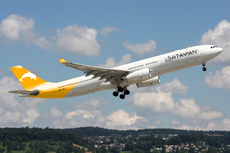
The new-look Satavian Airlines began services on 18 December 2007. The re-structured carrier was focused on the domestic and Asterian markets, with the vast majority of its wide-body fleet sold or scrapped; it however did retain four Boeing 747-400 in addition to some of its Airbus A330-300 fleet. In 2009, Satavian Airlines placed an order for ten new Boeing 787-8 aircraft, with a further option for six which the airline did not exercise.
By 2010, the carrier had re-established itself among the Asterian market, but had lost out to other Satavian airlines that had expanded in the immediate aftermath of the financial crisis, such as Air Hope and FlyBlu, in addition to other Asterian carriers. The Airline had also lost its slots at Morwall International Airport during the restructuring period, and in January 2011, it was reported that Satavian Airlines had purchased four landing slots at Morwall Airport from Air Gaullica for €56 million, at the time the most expensive landing slot purchase in aviation history. Later that year, on 15 April 2011, Satavian Airlines suffered its first fatal crash since Satavian Airways Flight 1884, when Satavian Airlines Flight 1445, an Airbus A320-200 suffered multiple bird strike and crash-landed just short of the runway, and into the M12 motorway that circles Northport J. D. Haynes Airport in the Orange Province. 54 people on the aircraft and the ground were killed. The STSB, Satavia's Air Accident investigator, published its final report in late 2012. It stated that the pilots had been warned about reports of a flock of birds in their path by Air Traffic Control, but neglected to deviate their course. The airline was sued by surviving relatives for 'breach of care' and in 2013 was ordered to pay €12.96 million to the families (or just over €240,000 per person), the largest such payout in Satavian aviation history. In early 2012, Satavian took possession of the first of ten Boeing 787-8, which was rolled out across Satavian's trans-Vehmens routes.
In 2013, Satavian Airlines rebranded Satavian Dolphin to Satavian Express, in addition to launching it's own low-cost regional airline, Vlugwell. By 2015, Vlugwell had become one of the largest low-cost carriers in Asteria Inferior. Satavian Airlines would later acquire low-cost rival FlyBlu in 2020.
In July 2016, the airline received the first of its Airbus A220 aircraft and was the regional launch customer; the jets replaced Satavian Airlines's outdated Boeing 737 and Airbus A319 aircraft. In 2018, Satavian Airlines strengthened its relationship with Airbus and received the first of sixteen planned Airbus A350-1000 aircraft, replacing the airline's Boeing 747-400 fleet. Due to a backlog at Airbus's sole A350 manufacturing plant in Verlois, Gaullica, the airline was forced to delay the final five examples and extend the 747's lifespan.
On 25 August 2019, it was announced that the Satavian Government would reduce its stake in the airline to 66%, with the remaining shares to be publicly traded on the Port Hope Stock Exchange. An estimated 20% stake in the company was acquired by the Dane-Moyne Group, which had originally acquired a controlling stake in the airline when it was first privatised in 1988. In 2020, the chairman of the board of directors Thady Stanhope resigned due to undisclosed personal reasons and was replaced by Derek Moyne, great-grandson of the airline's founder Neville.
Corporate affairs
Ownership and structure
As of April 2022, Satavian Airlines and its subsidiaries SatavianExpress and Vlugwell are majority-owned by the Government of Satavia, which has a 66% stake in the company. The Dane-Moyne Group, controls approximately 20% of the company with the rest of the shares being free-floating. Satavian Airlines Corporation Ltd. is listed on the Port Hope Stock Exchange, publicly traded as SATX, and domiciled in Port Hope, at Aviation House.
Head office
Satavian Airlines and its subsidiaries are headquartered in the Greystone suburb of Port Hope, across the river from Port Hope O'Connell International Airport. The facility includes three main 'terminals' - Aviation House, a building constructed in the early 1900s, which is situated between Dolphin House, constructed in 1989, and the most recent addition, the Moyne Center, constructed in 2017. Aviation House serves as the central headquarters for Satavian Airlines, whilst Dolphin House is occupied by SatavianExpress and Vlugwell offices. The Moyne Center houses overflow from the ageing Aviation House.
Subsidiaries
Operations subsidiaries
Satavian Airlines has two current subsidiaries: SatavianExpress and Vlugwell. Satavian Airlines previously had more subsidiaries: FlyBlu, Groenveldejet and oranjelug. SatavianExpress was first established in 1993 as Satavian Dolphin, and was later rebranded as SatavianExpress. The airline operates domestic flights across Satavia, using a fleet of Bombardier Q300 propeller planes and Airbus A318 and Airbus A319 jets. In 2020, Satavian Airlines acquired FlyBlu, a low-cost carrier and rival and integrated its fleet into SatavianExpress and Vlugwell. Vlugwell began operations in 2013 as Satavian's low-cost carrier and began by operating routes across Asteria and the Arucian. When Satavian acquired Groenveldejet and oranjelug in 2017 and 2018, Vlugwell took over both of the low-cost carrier's operations. In January 2022, Vlugwell opened its first trans-Vehmens route, a twice-weekly rotation from Victoriaburg to Zophar Bohannon International Airport in Port Fitzhubert, Rwizikuru.
Technical subsidiaries
The following are technical operations subsidiaries of Satavian Airlines:
- AirTegniek (50%) - joint venture between NLM and Satavian Airlines, formed through a merger of NLM's Tegniese Groep and Satavian's Satavian Airlines Engineering Services
- Cape James Flight Training Facility
- Cape James Ground Facilities
Sponsorship
Satavian Airlines is the main sponsor of the Dolphins, Satavia's national rugby union team, and has been since 2009. The airline was also the title sponsor of the Asterias Cup from 2003 to 2011. Satavian Airlines is also the primary sponsor of King's County Cricket Club, and its county ground, the Satavian Airlines Oval. From 2009 to 2016, the airline was the title sponsor of the Satavian Grand Prix, and ran SX-OCB in Satavian Grand Prix livery for three consecutive years, in 2011, 2012 and 2013.
Brand and livery
Satavian Airlines' symbol is the Hope River dolphin, a national symbol of Satavia that is included on its flag and coat of arms. The dolphin has featured on every standard aircraft livery since 1988 and is now a unique recognisable feature of Satavian Airlines aircraft. In 2008, as part of Air Satavia's rebranding to Satavian Airlines, a new fleet-wide livery, Native Danger, was rolled out. Its new colour scheme involved a primarily white fuselage, with a dark grey tail and an orange dolphin defacing the tail fin.
In 2018, the airline introduced a new livery, named Orange Tail, which is similar to the Native Danger livery, but the rear of the aircraft is painted orange, whilst the dolphin is painted white, and situated higher on the tail assembly.
- Gallery
Boeing 747-400, SX-GNL City of Port Hope, sporting the IAC Centenary livery
Boeing 747-400, SX-OCB Lady of the Arucian sporting the Satavian Grand Prix promotional livery
Special liveries
- In 1985, the airline celebrated the fiftieth anniversary of the airline's foundation with a special livery painted on some of Air Satavia's Boeing 747 aircraft.
- In 2000, a millenium livery was sported on one of Air Satavia's Boeing 747.
- In 2011, to promote the Satavian Grand Prix, the airline ran a Grand Prix livery on SX-OCB. They ran the livery until 2013.
- In 2019, the airline ran the 'eco livery' aboard SX-EIM, an aircraft renamed "Eco Warrior", to promote climate awareness. The livery was met with harsh responses and only ran for three weeks before the aircraft was repainted and renamed to its previous name, "Douglas D. Kingly".
- In 2019, SX-GNL, a Boeing 747, was repainted in a hybrid Satavian Airlines-Imperial Airways Corporation livery, to celebrate 100 years since the foundation of IAC, which is now Estmair.
Destinations
| Hub |
| Seasonal service |
Domestic
International
Satavian Airlines maintains codeshare agreements with the following airlines:
Fleet
Satavian Airlines operates a mainline fleet of Airbus and Boeing aircraft exclusively. Regional flights operated by Satavian Airlines' subsidiary SatavianExpress operate a fleet of Bombardier and Embraer regional jets. Satavian Airlines' low-cost subsidiary Vlugwell operates a fleet of Boeing 737 and Airbus A320 family aircraft, of which some are flown under the Satavian Airlines brand but operated by Vlugwell.
| Aircraft | In service | Orders | Passengers | Notes | ||||||
|---|---|---|---|---|---|---|---|---|---|---|
| F | J | W | Y | Total | ||||||
| Airbus A220-100 | 12 | — | — | — | 28 | 82 | 110 | Asteria Inferior launch customer for A220 family | ||
| Airbus A220-300 | 16 | — | — | — | 28 | 102 | 130 | Asteria Inferior launch customer for A220 family Airbus A220-300 fleet was briefily grounded following several mid-flight engine failures connected to loss of oil pressure in PW1500G engines | ||
| Airbus A320-200 | 7 | — | — | — | 32 | 124 | 156 | |||
| Airbus A321-200 | 14 | — | — | 14 | 32 | 160 | 206 | |||
| Airbus A330-300 | 24 | — | 8 | 48 | 88 | 140 | 284 | |||
| Airbus A350-1000 | 11 | 5 | 14 | 48 | 88 | 222 | 383 | 5 further examples are on order, but were delayed following production backlog at the Verlois plant | ||
| Boeing 747-400 | 4 | — | 12 | 48 | — | 356 | 416 | To be retired and replaced by Airbus A350-1000 aircraft planned for 2024 | ||
| Boeing 787-8 | 10 | — | 8 | 24 | 32 | 178 | 242 | |||
| Total | 98 | 5 | ||||||||
Cabin and services
Cabin
First class
First-class seats are offered exclusively on widebody international routes. The number of private suites ranges from eight on the Boeing 787-8 and Airbus A330-300 to 14 on the Airbus A350-1000. The seats are fully reclinable, offering an 83.5-inch seat pitch, and extend to a 208 cm flatbed. Each suite is equipped with an 18 inch (46 cm) HD in-flight entertainment system, in addition to USB ports and Apple compatible screens. All First-class private suites are fully enclosed and are arranged in a 1-1-1 configuration on all types, but suite size changes depending on the aircraft.
Traveller class
Business-class is offered on all international and some domestic routes. The Traveller class suites are configured in a 1-2-1 layout, and all seats have direct aisle access. On all aircraft, excluding the Airbus A321, business seats are fitted with an integrated 14 inch (36 cm) HD in-flight entertainment system.
Airbus A321
The Airbus A321 is fitted with Local Traveller seats, which are not fitted with in-flight entertainment systems and have a 42 inch (107 cm) seat pitch.
Premium economy
Premium economy is offered on all aircraft excluding the Boeing 747, and on international flights includes a personal in-flight entertainment system, and an extended seat pitch of 38 to 42 inches (97 to 107 cm). Premium economy is advertised as the 'perfect balance between luxury and necessity', and the total number of seats varies from 28 to 88.
Premium economy onboard the Airbus A220 and Airbus A320 does not necessarily include an IFE system (some Airbus A220-300 types do), and seat pitch and width are the same as the economy offering. However, the central seat on a row of three is left vacant, and in the case of the Airbus A220, one of the two seats on the left side of the aircraft is also left vacant.
Economy class
Economy class is offered on all mainline aircraft in a 2-3 configuration on the Airbus A220, a 3-3 configuration on the Airbus A320 and A321, a 2-3-2 configuration on the Airbus A330 and Boeing 787, and a 3-3-3 configuration on the Airbus A350 and Boeing 747. Seats pitch to 30 to 33 inches (76 to 84 cm).
All widebody flights are fitted with an integrated IFE system, with an 8 inch HD AVOD screen.
Entertainment
All aircraft, excluding the A320 and A321 aircraft are equipped with in-flight entertainment systems, specifically the Gaullican-made inteliQ system. The IFE offers options to order food, drinks and duty-free products, play video games and watch films. In addition, headphones are provided and all seats (excluding the A320 and A321 types) are fitted with USB charging points and the IFE systems can be connected to Apple products.
Satavian Airlines also provides passengers with an in-flight magazine, flySatavia, which includes Satavian Airlines and Sky Alliance news, duty-free and trending fashion articles.
Frequent flyer programme
Satavian Airlines frequent flyer programme, Dolphin Club, introduces passengers to a tiered system, compatible across all Sky Alliance members. Diamond, the highest available class, is followed by Gold, Silver and Black. Being a part of the Dolphin Club allows passengers to make use of exclusive lounges, priority boarding and faster check-in. By flying on Satavian Airlines, a passenger will accumulate SkyPoints, an alliance-wide points system, which is transferable between some alliance airlines, including Satavian Airlines.
Furthermore, members of the Dolphin Club will be prioritised for upgrades over non-members. Dolphin Club members also have access to other Sky Alliance airline lounges, in addition to Satavian Airlines' lounges.
Satavian Airlines is partnered with Barrett Bank, where holders of Dolphin Cards can accumulate points on purchases made using the Airline credit card.
Lounges
Satavian Airlines has lounge facilities at several different airports; its flagship lounge, the SIAC Lounge, is located in Terminal 2 at Port Hope/O'Connell Airport, the airline's primary hub. Satavian Airlines also operates lounges at Morwall International Airport, Port Arthur/Fort Kinnon and Victoriaburg. Furthermore, members of the airline's frequent flyer programme, the Dolphin Club, are able to make use of Sky Alliance lounges across the world.
Environmental issues
As part of the airline's climate pledge, it began research and development into sustainable fuels in partnership with Satoil and Clam. In 2019, the airline ran an 'eco livery' on one of its Airbus A330-300 aircraft, SX-EIM Eco Warrior, with the message "Go Green, Go Sustainable". The livery was accompanied by an advertising campaign aimed at spreading awareness of the climate crisis. The livery and advertising campaign prompted backlash from some politicians and the general public in Satavia, and the aircraft in question was re-painted just three weeks after the livery was first introduced.
Incidents and accidents
Satavian Airlines maintains a relatively clean safety record and is consistently ranked as one of the safest airlines in Asteria Inferior. Throughout its 87-year history, Satavian Airlines and its predecessors have suffered four accidents resulting in hull loss, and the deaths of 120 passengers and crew, in addition to nine people on the ground. Satavian Airlines in its current form has suffered only one fatal accident, Satavian Airlines Flight 1445.
- On 11 May 1943, a Douglas DC-4 (G-SVDL) crashed during a go-around at Morwall International Airport in poor weather, resulting in the death of all 42 passengers and crew.
- On 3 December 1947, a Douglas DC-5 (G-SVAI) struck the control tower at Port Arthur Aerodrome whilst landing in extreme crosswinds, resulting in the death of 25 of the 28 onboard the aircraft, in addition to all four Air Traffic Controllers.
- On 18 August 1959, a Vickers Viscount (SX-ADD) suffered substantial hull damage following the collapse of the front landing gear upon touchdown at Pietersburg International Airport, Nuvania. Despite a lack of fatalities, several people were seriously injured and the plane was eventually declared a hull loss and written off.
- On 29 January 1972, a Vickers VC10 (SX-ALO) suffered severe damage when it caught fire at Port Hope/O'Connell whilst parked at a ramp. A police investigation later ruled that the plane had been the target of arson. Two teenagers were later arrested, but released without charge. The plane was written off.
- On 30 November 1986, Satavian Airways Flight 1884, a Boeing 747-200, Lady of the Arucian (registered SX-NZX), lost power in all four engines whilst attempting to land at Morwall International Airport, and crash-landed 200 meters short of the runway, having struck the ILS beacon causing significant damage. The aircraft was written off, and four passengers died, in addition to 37 serious injuries.
- On 9 February 1999, a Boeing 737-400 (SX-NNP) clipped the empennage of another Air Satavia aircraft, a Boeing 757-200 (SX-LAO), ripping off the vertical stabiliser and damaging its own right-wing whilst taxiing at Port Hope/O'Connell International Airport.
- On 22 October 2004, an Airbus A320-200 (SX-POL) was destroyed whilst parked at a gate at Terminal 3, Port Hope/O'Connell following an electrical fire onboard the aircraft.
- On 15 April 2011, Satavian Airlines Flight 1445, an Airbus A320-200 (SX-DOA) suffered multiple bird strike, resulting in the loss of both engines. The pilots attempted to glide the plane towards the nearest airport, Northport J. D. Haynes Airport, but ultimately landed just short of the runway, crashing into the M12 motorway, killing 49 on board the aircraft, and five more on the ground.
- On 29 March 2017, an Airbus A220-300 (SX-SVC) suffered multiple engine failure connected to an oil pressure issue in the plane's engines. Satavian Airlines Flight 56 landed safely with no injuries, but the incident resulted in the temporary grounding of the A220-300 type whilst the issue was resolved.
- On 4 April 2022, an Airbus A220-300 (SX-SVA) struck a parked Cessna 172 Skyhawk at Port Arthur/Fort Kinnon. The Cessna suffered heavy damage and the Airbus A220 sustained minor damage to its undercarriage. The accident was attributed to controller error, and none were hurt in the incident.
Notes
- ↑ Naua Roa is internationally considered to be a non self-governing territory of Satavia

